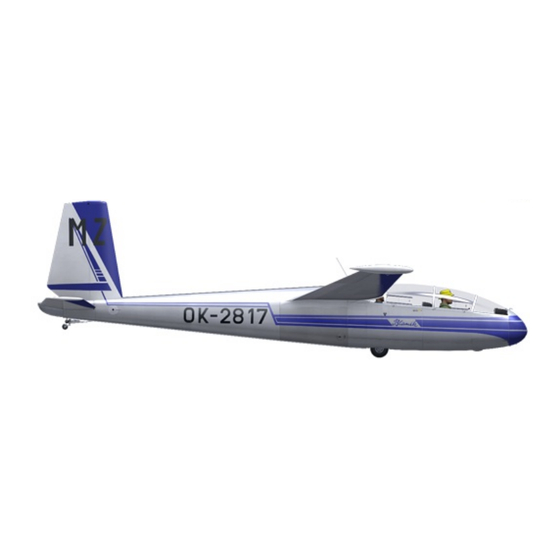
Table of Contents
Advertisement
Quick Links
Advertisement
Table of Contents

Summary of Contents for Octopus G L-13 Blanik
-
Page 2: Table Of Contents
INDEX 1 HYSTORY 2 CONSTRUCTION 3 DIMENSIONS 4 PERFORMANCE 5 PANELS 6 FLYING 8 PREFLIGHT INSPECTION 9 PRE TAKEOFF CHECK 10 WINCH LAUNCHING 11 AEROTOW LAUNCHING 12 CLIMB 13 FREE FLIGHT 14 APPROACH AND LANDING 15 OFF-FIELD LANDING 16 STALL 17 BASIC AEROBATICS 18 LOOP 19 STALL TURN... -
Page 3: Hystory
HISTORY The L-13 Blanik is a two seater trainer glider produced by Let Kunovice since 1956. It is the most numerous and widely used glider in the world. In United States Air Force Academy service, it is designated TG-10C and is used for basic flight training. -
Page 4: Dimensions
DIMENSIONS Lenght, m Wing span, m 16,2 Wing area, m 19,5 PERFORMANCE Vne, kmh: Minimum vertical speed, m/sec: 0,82 Vne (air brakes extended), kmh: Max. tow speed, kmh: flaps down: flaps up: Max winch launch speed, kmh: flaps down: flaps up:... -
Page 5: Panels
PANELS 14. Brake lever Altimeter 15. Radio bottom Magnetic compass 16. Volume regulator VSI (for 5 m/s) 17. Noise switch Turn coordinator 18. Frequency selection switch VSI VR-30 19. Pedals regulator Trim lever 20. Frequency selection switch Air brakes lever 21. -
Page 6: Flying
FLYING PREFLIGHT INSPECTION Examine the sailplane for external damage. Check that a wing and tai1p1ane attachment and control assembly pins are secure Check that the canopy jettison lever has not been operated accidentally. and that the sealing wire is intact. Inspect the cockpit hood for damage and, clean it and demist the interior if necessary. -
Page 7: Pre Takeoff Check
harnesses are not damaged and are securely attacked to the glider. Remove all loose articles not wanted in flight and, if the sailplane is to be flown solo, secure the rear safety harness and seat cushions. PRE TAKEOFF CECK Safety Harness: Enter the cockpit and fasten the safety harness, insuring that it is fully and tightly fitted. -
Page 8: Winch Launching
Flight Controls: Both the control column and the ruder pedals should be checked again for and free movement in all directions. When checking the aileron controls, the wing tip should be lifted clear of the ground so as to prevent damage to the aileron. Wheel Brake: Check the wheel brake lever (6) for free move ment, and ensure that it is in the fully off position. -
Page 9: Climb
CLIMB Retract and lock the landing gear (by pulling the handle in your direction) when above a minimum safe height of 20 m (66 ft). Trim the sailplane for the climb speed. Smoothly moving the stick and pedals keep the sailplane behind the aircraft or slightly at the side, but do not allow too large deviations to avoid aerotow brake. -
Page 10: Stall
Note: In case of using air brakes during landing, it is necessary to maintain an approach speed of about 10 km/h (5 kts) higher, because the stall speed with fully opened air brakes is about 5-7 km/h (3- 4 kts) higher. 3. -
Page 11: Basic Aerobatics
BASIC AEROBATICS Table of speeds for basic aerobatics (km/h) Solo Dual Barrel roll forbidden Loop Stall turn Immelmann 180-190 190-200 Split S Inverse flight Above 130 forbidden LOOP Enter a moderate dive with slight forward movement of the control stick to gain a speed of 160 km/h (86 KIAS) when flying solo or 180 km/h (97 KIAS) when flying dual. -
Page 12: Stall Turn
not use more than about 60 % of the control stick full deflection. The load factor must drop in the inverted position. After passing the inverted position the speed will increase and the control stick must be eased forward gradually until the sailplane is flying level again. Before and during this manoeuvre rudder should be used to prevent yaw and ailerons used to keep the wings level. -
Page 13: Immelmann
IMMELMANN The initial speed for Immelmann is of about 180-190 km/h when flying solo or 190-200 km/h when flying dual. Raising the nose of the sailplane is faster with respect to loop. After distinguishing of the top point return the stick to have weightless state. Then deflect tne ailerons to turn in normal position. -
Page 14: Split S
SPLIT S At the beginning of this figure the speed should be 130 km/h when flying solo or 140 km/h when flying dual. Rise the nose of the glider till 25° above horizon. Then push the stick forward for direct flight and deflect the ailerons. -
Page 15: About
sailplane with full deflection of the ailerons. At the bank 90° push the upper rudder if the sailplane nose goes down. In the inverse position push the stick forward to keep the axis of the fuselage. During the roll the ailerons are always fully deflected. At the second phase of the roll use rudder and elevator to prevent non desirable turns of the sailplane: the upper pedal at about 90°...
Need help?
Do you have a question about the L-13 Blanik and is the answer not in the manual?
Questions and answers